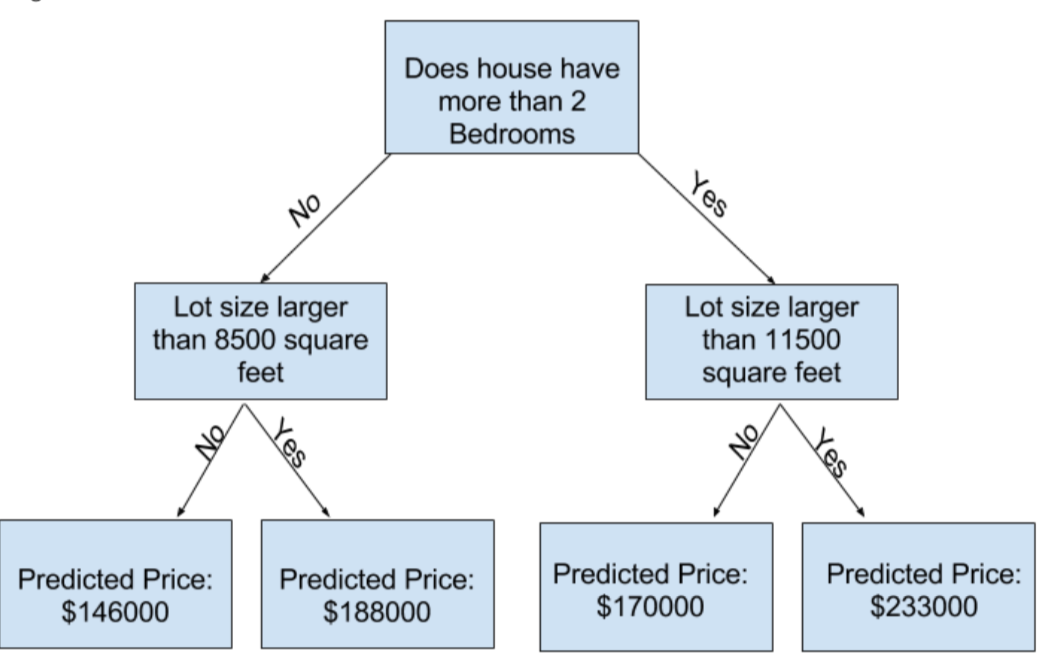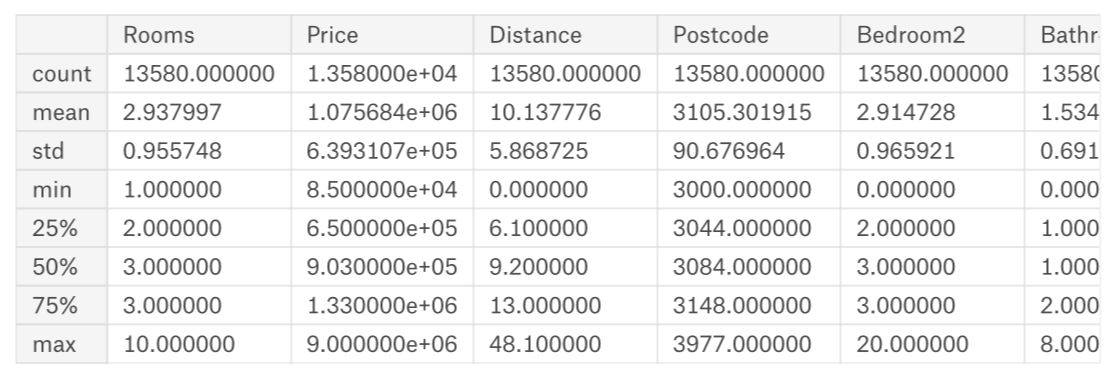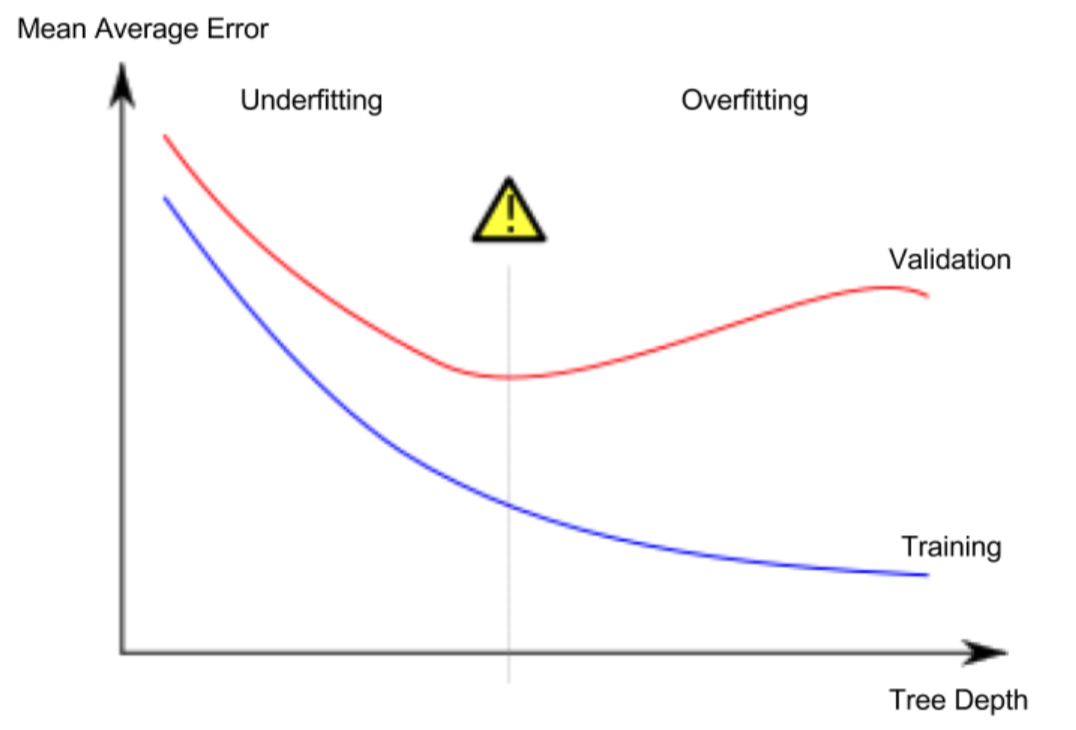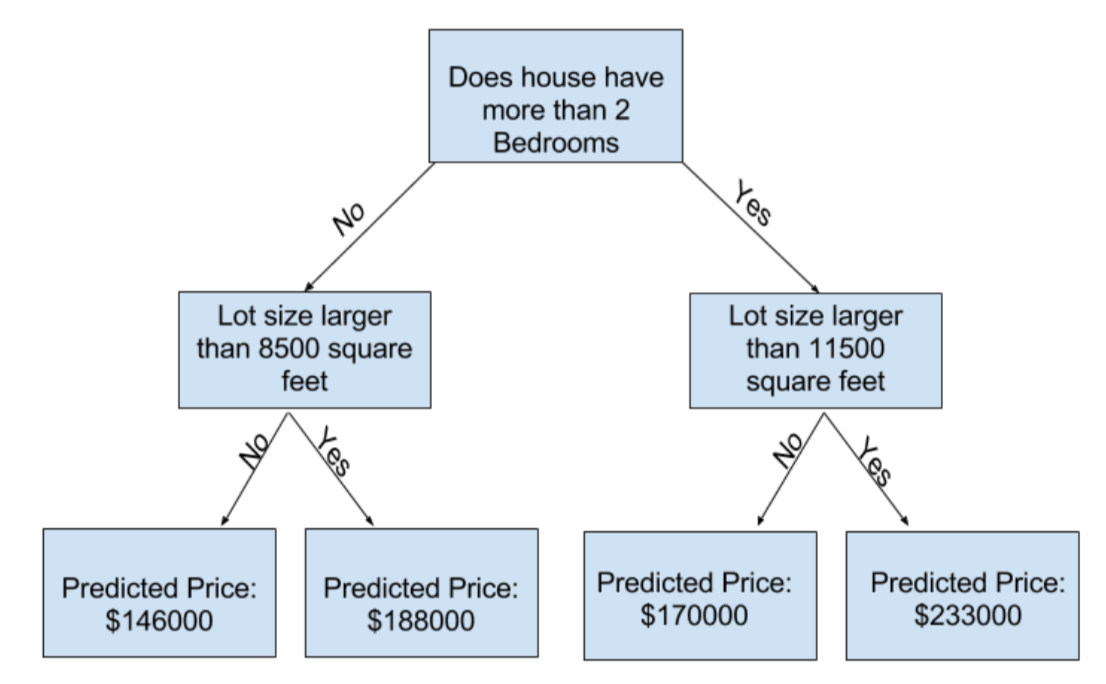Intro to Machine Learning
本节主要用于机器学习入门,介绍两个简单的分类模型:
决策树和随机森林
不涉及内部原理,仅仅介绍基础的调用方法
1. How Models Work
以简单的决策树为例
This step of capturing patterns from data is called fitting or training the model
The data used to train the data is called the trainning data
After the model has been fit, you can apply it to new data to predict prices of additional homes

2.Basic Data Exploration
使用pandas中的describle()来探究数据:
melbourne_file_path = '../input/melbourne-housing-snapshot/melb_data.csv'
melbourne_data = pd.read_csv(melbourne_file_path)
melbourne.describe()
output:

注:数值含义
count: 非缺失值的数量
mean: 平均值
std: 标准偏差,它度量值在数值上的分布情况
min、25%、50%、75%、max: 将每一列按照从lowest到highest排序,最小值是min, 1/4位置上,大于25%而小于50%是25%
3.Your First Machine Learning Model
- Selecting Data for Modeling
import pandas as pd
melbourne_file_path = ' ../input/melbourne-housing-snapshot/melb_data.csv'
melbourne_data = pd.read_csv(melbourne_file_path)
- Selecting The Prediction Target
方法:使用dot-notation来挑选prediction target
- Choosing "Features"
melbourne_features = ['Rooms', 'Bathroom', 'Landsize', 'Lattitude', 'Longtitude']
X = melbourne_data[melbourne_features]
查看数据是否加载正确:
X.head()
探究数据基本特性:
- Building Your Model
我们使用scikit-learn来创造模型,scikit-learn教程如下:
具体的原理可以根据需要自己探究
https://scikit-learn.org/stable/supervised_learning.html#supervised-learning
构建模型步骤:
- Define:
What type of model will it be? A decision tree? Some other type of model? Some other parameters of the model type are specified too.
- Fit:
Capture patterns from provided data. This is the heart of modeling
- Predict:
Just what it sounds like
- Evaluate:
Determine how accurate the model's predictions are
实现:
from sklearn.tree import DecisionTreeRegressor
melbourne_mode = DecisionTreeRegressor(random_state=1)
melbourne_mode.fit(X , y)
打印出开始几行:
print (X.head())
预测后的价格如下:
print (melbourne_mode.predict(X.head())
4.Model Validation
由于预测的价格和真实的价格会有差距,而差距多少,我们需要衡量
使用Mean Absolute Error
error= actual-predicted
在实际过程中,我们要将数据分成两份,一份用于训练,叫做training data, 一份用于验证叫validataion data
from sklearn.model_selection import train_test_split
train_X, val_X, train_y, val_y = train_test_split(X, y, random_state=0)
melbourne_model = DecisionTreeRegressor()
melbourne_model.fit(train_X, train_y)
val_predictions = melbourne_model.predict(val_X)
print(mean_absolute_error(val_y, val_predictions))
5.Underfitting and Overfitting
- overfitting: A model matches the data almost perfectly, but does poorly in validation and other new data.
- underfitting: When a model fails to capture important distinctions and patterns in the data, so it performs poorly even in training data.

The more leaves we allow the model to make, the more we move from the underfitting area in the above graph to overfitting area.

from sklearn.metrics import mean_absolute_error
from sklearn.tree import DecsionTreeRegressor
def get_ame(max_leaf_nodes, train_X, val_X, train_y, val_y):
model = DecisionTreeRegressor(max_leaf_nodes = max_leaf_nodes, random_state = 0)
model.fit(train_X, train_y)
preds_val = model.predict(val_X)
mae = mean_absolute_error(val_y, preds_val)
return(mae)
我可以使用循环比较选择最合适的max_leaf_nodes
for max_leaf_nodes in [5,50,500,5000]:
my_ame = get_ame(max_leaf_nodes, train_X, val_X, train_y, val_y)
print(max_leaf_nodes, my_ame)

最后可以发现,当max leaf nodes 为 500时,MAE最小, 接下来我们换另外一种模型
6.Random Forests
The random forest uses many trees, and it makes a prediction by averaging the predictions of each component tree. It generally has much better predictive accuracy than a single decision tree and it works well with default parameters.
from sklearn.ensemble import RandomForestRegressor
from sklearn.metrics import mean_absolute_error
forest_model = RandomForestRegressor(random_state=1)
forest_model.fit(train_X,train_y)
melb_preds = forest_model.predict(val_X)
print(mean_absolute_error(val_y, melb_preds))
可以发现最后的误差,相对于决策树小。
one of the best features of Random Forest models is that they generally work reasonably even without this tuning.

7.Machine Learning Competitions
- Build a Random Forest model with all of your data
- Read in the "test" data, which doesn't include values for the target. Predict home values in the test data with your Random Forest model.
- Submit those predictions to the competition and see your score.
- Optionally, come back to see if you can improve your model by adding features or changing your model. Then you can resubmit to see how that stacks up on the competition leaderboard.
最新文章
- 怎么样在Myeclipse中配置JDK?
- MySQL安装与基本配置
- Android开发学习之路-图片颜色获取器开发(1)
- Mybatis拦截器 mysql load data local 内存流处理
- 高效coder,筹备开源框架toutou.escort.js
- 嵌入支付宝SDK,出现“LaunchServices: ERROR: There is no registered handler for URL scheme alipay”错误
- Java之构造器的作用
- 【转载】Pyqt 添加右键菜单方法
- 第一个windows程序设计
- UIImage 调整图片大小
- sql 语句中使用条件判断case then else end
- 第三百三十一天 how can I 坚持
- Android播播放完SD卡指定文件夹音乐之后,自动播放下一首
- HIVE中内连接和左半连接不一致问题
- bzoj1821
- 颜色rgb
- mysql merge table
- 对Unity3d C#手动处理异常产生
- javascript里的循环语句
- habse Region server挂掉